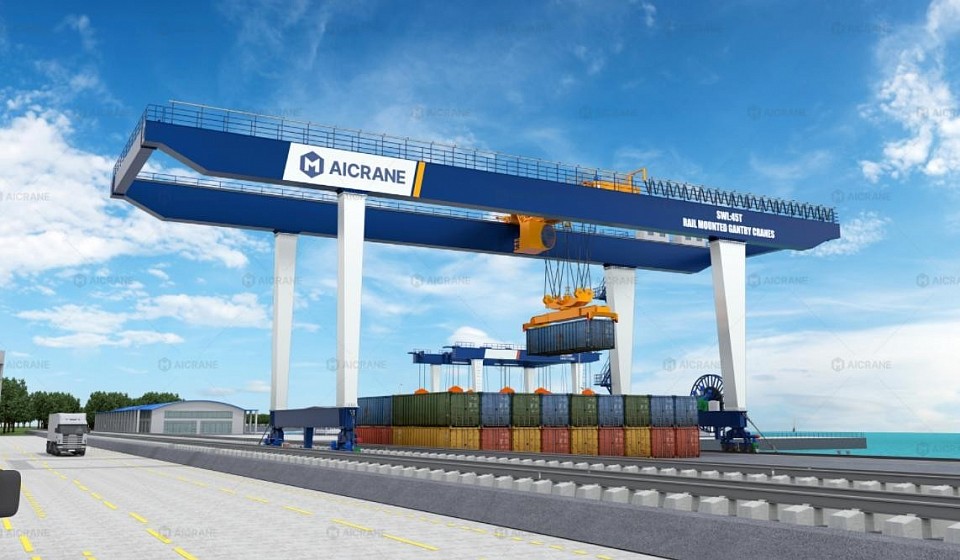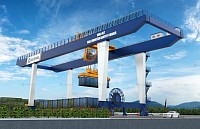Ensuring Safety and Operational Efficiency Through Structural Design and Wind Management
Rail Mounted Gantry (RMG) cranes play a critical role in modern port operations, container handling yards, and heavy-duty material handling facilities. These massive cranes, often spanning over 40 meters and capable of lifting hundreds of tons, are designed to operate in open environments where wind conditions can fluctuate significantly. The design of an RMG crane must, therefore, incorporate rigorous considerations for wind resistance and structural stability, ensuring safety, operational efficiency, and long-term reliability.
Understanding Wind Loads on RMG Cranes
Wind load is a primary environmental factor affecting RMG cranes. Due to their height and expansive surface areas, these rail gantry cranes are particularly vulnerable to lateral forces generated by wind. The wind can exert pressure on the crane's gantry, trolley, and spreader, resulting in forces that may induce vibrations, sway, or even structural deformation if not properly accounted for in the design.
Wind forces acting on RMG cranes can be classified as follows:
Static Wind Load: This represents the steady, continuous pressure exerted by wind on the crane structure. Designers calculate this load using local wind speed data, accounting for variations over time and height above ground.
Dynamic Wind Load: Gusts and turbulence can create fluctuating forces that may amplify structural responses. Dynamic loading is particularly critical for the crane’s boom, trolley, and overhead bridge, as it can cause oscillations that interfere with precise container handling.
Impact of Wind on Lifting Operations: Wind is not only a structural concern but also an operational one. Lifting a container in high wind conditions can cause swinging, leading to potential accidents or damage. RMG cranes often incorporate operational limits or automatic shutdown protocols when wind exceeds safe thresholds.
Structural Design for Wind Resistance
Designing an RMG crane to withstand wind involves optimizing the crane’s geometry, materials, and connections. Key considerations include:
1. Crane Frame Design
The main structure of an RMG crane—the gantry and its supporting legs—must resist bending and torsional forces caused by lateral wind pressure. Common strategies include:
Triangular or lattice girders: Lattice structures reduce wind exposure by allowing airflow through the crane, thereby decreasing wind pressure on the surfaces.
Box-section girders: For critical load-bearing components, closed box sections provide torsional rigidity while maintaining strength-to-weight efficiency.
2. Material Selection
The choice of steel grade and structural material significantly affects wind resistance. High-strength, low-alloy steel is commonly used to balance weight, strength, and flexibility. This ensures that the crane can withstand wind loads without excessive deflection, which might compromise operational accuracy.
3. Wind Load Calculations
Engineers use standards such as ISO 12491 (for container handling cranes) or national equivalents to determine design wind loads. Factors considered include:
Basic wind speed in the region
Terrain category (open water, urban, or flatland)
Height of the crane above ground level
Shielding effects from nearby structures
These parameters help define the design wind pressure, which is then applied to the crane structure in structural analysis simulations.
Stability Considerations
While wind resistance primarily focuses on the structural ability to withstand lateral forces, stability ensures that the crane remains upright and operational under all conditions. Key stability considerations include:
1. Rail and Foundation Stability
RMG cranes operate on rails, which distribute loads to the ground. Stability analysis must consider:
Wheel base and span width: A wider span enhances lateral stability against tipping forces from wind.
Rail alignment and foundation rigidity: Any unevenness or flexibility in the foundation can exacerbate sway under wind pressure.
Rail anchoring and tie-down systems: In extreme conditions, some RMG cranes include mechanical locks or brakes to prevent lateral movement along rails.
2. Center of Gravity
The crane’s center of gravity plays a crucial role in its stability. Design measures include:
Positioning heavy components, such as hoist machinery and electrical cabins, closer to the base of the crane.
Balancing the weight distribution of trolley and spreader mechanisms.
Adjusting counterweights, when used, to optimize overall stability.
3. Anti-Sway Systems
Advanced RMG cranes incorporate active or passive anti-sway systems. These systems help control the oscillation of the trolley and lifted loads in high winds, preventing dangerous swaying that could destabilize the crane.
Active systems use sensors and hydraulic or electric actuators to adjust motion in real time.
Passive systems rely on mechanical damping to absorb kinetic energy from swaying loads.
Operational Safety Measures for Wind Conditions
Beyond structural design, operational strategies are critical for wind resistance and crane stability:
Wind Monitoring Systems: Real-time anemometers installed on cranes can detect wind speed and direction, automatically triggering operational limits or shutdowns.
Load Restrictions: Operational manuals often specify maximum load capacities under various wind speeds to prevent tipping or excessive sway.
Scheduled Inspections: High winds can stress joints, bolts, and connections. Regular inspection ensures that structural integrity is maintained.
Computational Modeling and Simulation
Modern RMG crane design heavily relies on Finite Element Analysis (FEA) and Computational Fluid Dynamics (CFD) simulations to predict wind effects. These tools allow engineers to:
Simulate wind pressures on the crane’s surfaces.
Identify potential points of failure or excessive deflection.
Optimize structural elements for both weight and stiffness.
Simulations also help design emergency scenarios, such as extreme gusts, enabling engineers to integrate automatic locking mechanisms or temporary windbreak solutions.
Case Studies: Lessons from Real-World RMG Applications
Several port authorities worldwide have implemented RMG cranes designed with wind resistance as a core criterion:
European Northern Ports: Ports in coastal areas with high wind frequencies use lattice-style RMG cranes with reinforced legs and automated wind-monitoring systems.
Asian Mega-Terminals: In typhoon-prone regions, cranes are equipped with sensors to halt operations when wind exceeds predefined thresholds, while structural design includes robust foundations and wider spans to prevent tipping.
North American Container Yards: Modern RMG cranes integrate predictive analytics with weather data to adjust lifting speeds and trolley acceleration in response to wind, enhancing both safety and operational efficiency.
Conclusion
Wind resistance and stability are fundamental aspects of RMG crane design. These cranes must withstand continuous and dynamic wind loads while maintaining precise and safe operations. By integrating robust structural designs, advanced materials, computational simulations, anti-sway systems, and operational safety protocols, engineers ensure that RMG cranes remain reliable in diverse environmental conditions.
Incorporating wind resistance measures not only protects the crane structure but also ensures the safety of personnel, cargo, and surrounding infrastructure. Port operators and engineers must collaborate closely to implement these design principles, selecting cranes optimized for the specific wind conditions of their operational environment.
Ultimately, an RMG crane that excels in wind resistance and stability represents a balance of engineering excellence, operational foresight, and environmental adaptation, making it a cornerstone of efficient, safe, and sustainable container handling operations.


